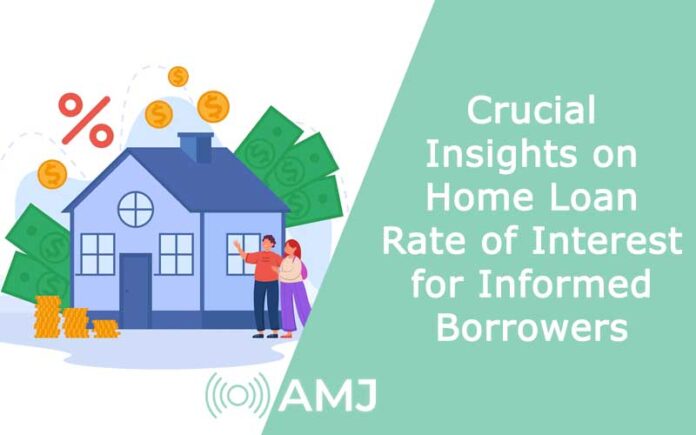Venturing into a journey towards homeownership is an exciting yet complex endeavour, with the web of home loan intricacies often posing a challenge. Among these complexities, understanding the dynamics of the home loan rate of interest stands out as a crucial factor for making an informed financing decision.
Through the medium of this blog, we enter into a comprehensive exploration of the intricacies surrounding a home loan rate of interest. It will aim to empower you, a potential homeowner, with the knowledge needed to make astute financial decisions.
As we explore, we’ll uncover essential insights that can secure a roof over your head and pave the way for a stable, prosperous financial future. Let us begin by understanding the basics of the home loan rate of interest.
Contents
The Basics of Home Loan Rate of Interest
The fundamental aspect of learning about the home loan rate of interest is its two types offered during a loan – fixed or floating. These types describe how the interest on the loan is calculated and whether it remains constant or fluctuates over time:
- Fixed Rate
A fixed interest rate is exactly what its name suggests—fixed. Once you secure a home loan with a fixed rate, the interest percentage remains constant throughout the entire loan tenure. It implies that your monthly payments remain the same, providing a sense of stability and predictability for budgeting purposes. Even if market interest rates rise or fall, your interest rate remains unchanged, offering protection from fluctuations in the financial market.
- Floating Rates (Adjustable or Variable Rates)
A floating interest rate (also known as an adjustable or variable rate) fluctuates in response to changes in market interest rates. This type of home loan rate of interest is often tied to a benchmark, such as the prime rate or a specific financial index. As market rates change, so does the interest rate on the loan, leading to variations in monthly payments. This rate type introduces an element of uncertainty into the loan, as you may experience fluctuations in your repayment amounts over time.
Here is a tabular difference to understand more about these types of home loan rates of interest:
| Characteristic | Fixed Interest Rates | Floating Interest Rates |
| Nature of Rate | Constant throughout the loan tenure | Fluctuates based on market conditions |
| Monthly Payments | Remain the same throughout the loan period | May vary as they are influenced by changes in market rates |
| Predictability | High; borrowers can accurately forecast monthly payments | Lower; monthly payments can change, introducing uncertainty |
| Market Impact | Insulated from market rate fluctuations | Directly affected by changes in market interest rates |
| Risk Tolerance | Suitable for those who prioritise stability and want to avoid interest rate risk | Suited for borrowers comfortable with potential payment fluctuations and seeking to benefit from market rate changes |
| Initial Rates | May be higher than the initial rates for floating rates | May start lower than initial fixed rates |
| Long-term Planning | Ideal for those who prefer a consistent, unchanging financial commitment | Requires flexibility and adaptability to handle potential changes in payments |
Credit Score and Its Impact on Home Loan Rate of Interest
As a borrower, your credit score is a crucial element that significantly influences the home loan rate of interest offered by lenders. It is a numeric representation of your creditworthiness, reflecting your financial history and how responsibly you manage credit. Lenders utilise this score to assess the risk associated with lending to you. A higher credit score generally signifies lower risk, making you more attractive to lenders. Maintaining a high credit score not only increases the chances of loan approval but also opens doors to more favourable interest rates.
Maintaining a healthy credit score is essential for securing the best possible home loan rate of interest. Here are some practical steps to enhance your creditworthiness:
- Pay all bills, including credit cards and loans, on time to demonstrate financial responsibility.
- Keep credit card balances low in relation to your credit limit, as high utilisation can negatively impact your score.
- Maintain a diverse credit history over time, showcasing responsible credit management.
- Periodically check your credit report for errors and address any discrepancies promptly.
Loan-to-Value Ratio (LTV) and its Role
The Loan-to-Value Ratio is a crucial metric that reflects the relationship between the loan amount and the property’s appraised value. Lenders consider LTV when determining the risk associated with a loan. As a borrower, you must understand how LTV affects a home loan rate of interest, which can empower you to make strategic decisions when it comes to down payments and property choices.
Secure the Best Home Loan Rate of Interest
When making any financial decision, it is essential to gain sufficient knowledge about the loan or related terms. Consequently, for home loans, the interest rate is a critical factor that may significantly impact your financial journey. With the aforementioned information, you can make a choice that aligns with your preferences.
If you are looking for the best home loan rate on interest, you can explore the loans offered by Tata Capital. You can secure a loan from ₹ 5 lakhs to ₹ 5 crores at competitive interest rates. Visit their website to learn more about home loans and their interest rates.












![Index of Money Heist [Season 1, 2, 3 & 4 – All Episodes, Cast and Plot] Index of Money Heist](https://www.asiamediajournal.com/wp-content/uploads/2021/05/Index-of-Money-Heist-3-100x70.jpg)